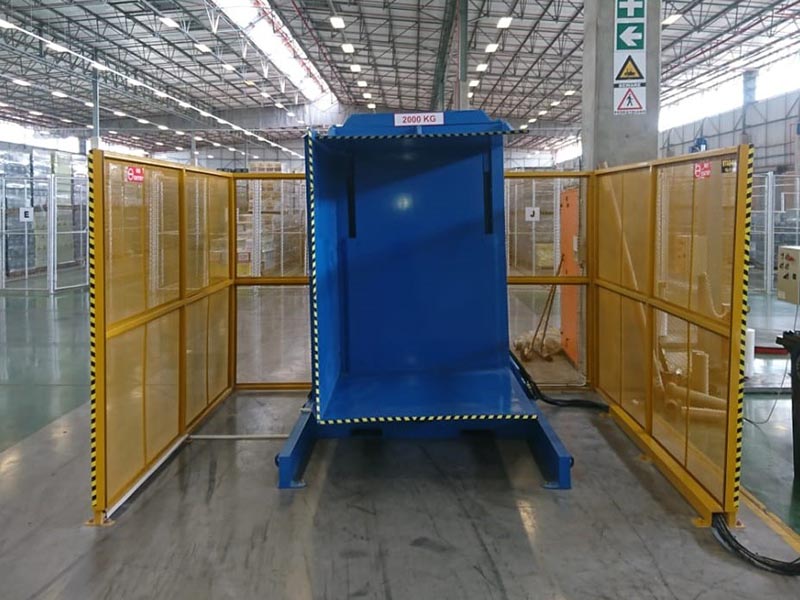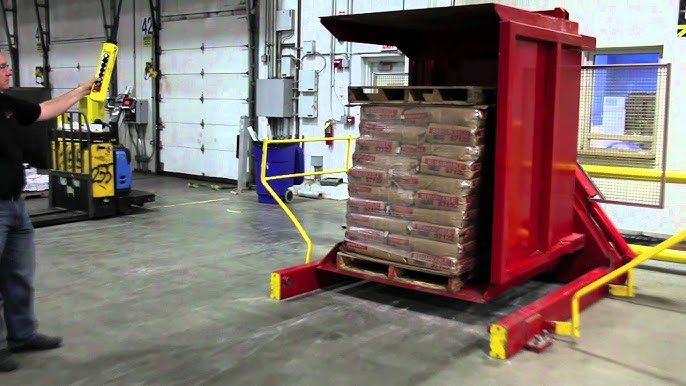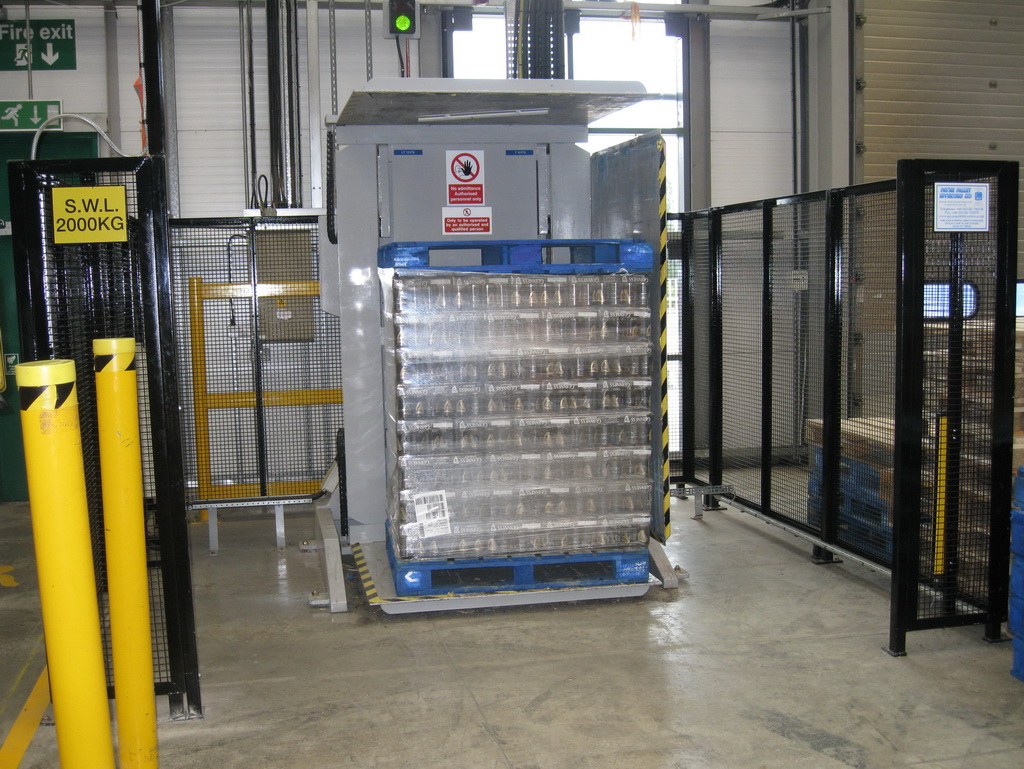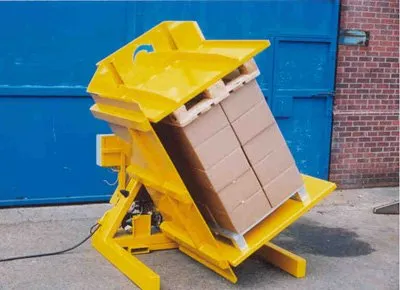Pallet Changing Machine: What’s the ROI on Automated Pallet Swaps?
Are you still swapping pallets by hand? I see it all the time. A team of workers stops the line, manually unloads a pallet, and then re-stacks everything onto a new one. It’s slow, it’s a safety risk, and it’s a major bottleneck in an otherwise efficient operation. In industries like steel manufacturing, where every minute of production counts, this manual process eats away at your profits. You face risks of worker injury, product damage, and costly downtime. It's a persistent problem that seems too small to tackle, but its hidden costs add up quickly. The solution is simpler than you think: an automated pallet changing machine. It swaps entire loads in seconds, not minutes. But the big question always is, does the investment actually pay for itself?
The ROI on an automated pallet changing machine is typically realized within 12 to 24 months. This return is driven by a combination of direct labor cost savings, a sharp reduction in product damage, increased operational throughput, and significantly improved worker safety. For a high-volume facility like a steel mill or a busy distribution center, this translates directly into tens of thousands of dollars in measurable annual savings and productivity gains.

I've been in this industry for a long time, first as an engineer on the factory floor and now as the owner of SHJLPACK. I’ve seen firsthand how a single piece of equipment can transform an entire operation. A pallet changer isn't just about moving goods; it's about creating a smoother, faster, and more profitable workflow. It solves the kinds of problems that keep plant managers and CEOs like Javier Morales up at night—problems like rising labor costs, aging equipment, and the constant pressure to improve efficiency. Let's break down the numbers and look at the real, tangible returns you can expect from making this switch.
How do you calculate the direct labor savings from a pallet changer?
You see your team spending time on manual tasks, but can you put an exact dollar amount on the cost of swapping pallets? It feels like a small part of the day, but when you add it all up, the numbers are often shocking. Without a clear calculation, it's hard to justify investing in new automation. You're left relying on gut feelings while labor costs continue to climb and your operational efficiency remains stagnant. There's a straightforward way to calculate this. By breaking down the costs step-by-step, you can build a solid business case and see exactly how much money you're leaving on the table.
To calculate direct labor savings, you use a simple formula: multiply the number of workers assigned to the task by their fully-loaded hourly wage, then multiply that by the time it takes them to swap one pallet. Finally, multiply that by the total number of swaps you perform each day. An automated pallet changer can reduce the time and labor components of this equation by over 90%, revealing an immediate and significant area for cost reduction.

I remember visiting a client, a steel wire processor, who was struggling with this exact issue. They had two workers spending about 15 minutes to manually transfer a heavy coil of wire from a production pallet to a shipping pallet. They did this about 20 times a day. When we did the math together, the owner was stunned. He was spending thousands of dollars every month just on that one simple task. This is a common story. The cost is hidden in plain sight. Let's look deeper into how you can uncover these costs in your own facility.
Step-by-Step Cost Calculation
The first step is to get accurate numbers. Don't guess. Time the process over a few days to get a reliable average.
- Identify Workers: How many people does it take to swap a pallet? (Let's say 2 workers).
- Calculate Labor Rate: What is their fully-loaded hourly wage? This isn't just their base pay. You must include benefits, payroll taxes, and insurance. (Let's use an example of $25/hour per worker).
- Measure Time: How long does the manual swap take in minutes? (e.g., 15 minutes, or 0.25 hours).
- Count Swaps: How many pallets do you swap per shift or per day? (e.g., 30 swaps per day).
The formula is: (Number of Workers) x (Hourly Wage) x (Time per Swap in Hours) x (Swaps per Day).
Using our example: 2 workers x $25/hour x 0.25 hours x 30 swaps/day = $375 per day in manual labor cost.
An automated pallet changer performs the same task in about 2 minutes with one supervisor. The new cost is: 1 worker x $25/hour x (2/60 hours) x 30 swaps/day = $25 per day. That's a daily saving of $350.
Factoring in Real-World Variables
The simple calculation is just the start. In a real factory environment, other factors increase the cost. Overtime is a big one. If your line runs behind, you might pay workers time-and-a-half to catch up, and manual bottlenecks are a primary cause of this. Also, consider worker churn. Manual handling is physically demanding work, leading to higher turnover. The costs of recruiting, hiring, and training new employees for these roles are substantial. An automated system reduces this physical strain, leading to a more stable and experienced workforce.
Manual vs. Automated: A Clear Comparison
Let's put this into a table to make it crystal clear. This is the kind of analysis a practical leader like Javier Morales would demand before signing off on any capital expenditure.
| Metric | Manual Pallet Swapping | Automated Pallet Changer |
|---|---|---|
| Workers per Swap | 2 | 1 (supervisor) |
| Time per Swap | 15 minutes | 2 minutes |
| Swaps per 8-Hour Shift | 32 | 240 (potential) |
| Cost per Swap | $12.50 | $0.83 |
| Daily Cost (30 Swaps) | $375.00 | $25.00 |
| Annual Cost (250 days) | $93,750 | $6,250 |
| Annual Savings | - | $87,500 |
The numbers speak for themselves. The savings on direct labor alone often provide a payback period of well under two years for the machine. This is the first, and most obvious, part of your ROI.
You've calculated the labor savings, and the number is impressive. But that's just the tip of the iceberg. There are other, less obvious costs tied to manual pallet handling that are silently draining your budget. Think about a dropped pallet of finished goods, a worker out on compensation leave, or a shipment rejected due to contamination from a wooden pallet. These incidents are unpredictable, but they happen. They represent significant financial risks that eat directly into your profit margins and disrupt your operations. An automated pallet changing machine is designed to address these very issues, creating a more predictable, safe, and clean process.
The most significant hidden costs of manual pallet swapping are product damage, worker injuries, and quality control failures. Manual handling can lead to damage rates of 1-3% of goods, while a single workplace injury can cost tens of thousands in claims and lost time. An automated pallet changer minimizes these risks by handling loads with mechanical precision, virtually eliminating human error and strain.

I once worked with a CEO of a large beverage company. He was focused on labor costs, but his biggest problem was actually product damage. His team was moving stacks of glass bottles, and every time a pallet was handled roughly or dropped, he lost thousands of dollars in an instant. The mess also caused significant downtime for cleanup. When we installed a pallet inverter, which gently tilts the load to swap the pallet, his damage rate fell to nearly zero. The savings from preventing just one or two of these incidents a month paid for the machine faster than the labor savings did. These hidden costs are real, and they matter.
Quantifying the Cost of Product Damage
In a steel mill, this is a critical issue. A steel coil is a high-value product. If the edge is dented or the wrapping is torn during manual handling, the customer might reject the entire coil. Let's say a single coil is worth $2,000. If manual handling leads to a damage rate of just 1% on 50 pallet swaps per day, you could be losing one coil per day on average. That's a $2,000 daily loss, or a potential $500,000 loss annually. An automated system handles the coil with consistent, gentle pressure. It secures the load before moving it, which drastically reduces the chance of scrapes, dents, or drops. This protects your revenue and your reputation for quality.
The True Cost of a Workplace Injury
This is a cost no business owner wants to face. Manual lifting, twisting, and handling of heavy loads are leading causes of musculoskeletal injuries. The direct costs are easy to see: medical bills and worker compensation premiums. But the indirect costs are often much larger. These include:
- Lost production time while the injured worker is away.
- Time spent by supervisors and HR managing the incident report and claim.
- The cost of training a replacement worker.
- A negative impact on team morale and safety culture.
A single serious injury can easily exceed $50,000 in total costs. An automated pallet changer removes the physical strain from your employees, making the workplace fundamentally safer. This isn't just about saving money; it's about protecting your people, which is the most valuable asset in any factory.
Hidden Costs Analysis: Manual vs. Automated
Let's put these hidden costs into a comparative table. These are estimates, but they illustrate the financial risk you mitigate with automation.
| Hidden Cost Factor | Manual Pallet Swapping (Annual Estimate) | Automated Pallet Changer (Annual Estimate) |
|---|---|---|
| Product Damage | 1.5% of handled value ($75,000) | <0.1% of handled value ($5,000) |
| Workplace Injury | 1 moderate incident ($30,000) | Risk dramatically reduced ($0) |
| Quality/Contamination | Cost of re-work/rejection ($15,000) | Process standardized ($1,000) |
| Total Hidden Costs | $120,000 | $6,000 |
| Annual Savings | - | $114,000 |
When you add these hidden cost savings to the direct labor savings, the ROI for a pallet changing machine becomes undeniable. It moves from being a cost center to a strategic tool for risk management and quality assurance.
How does a pallet changing machine impact overall production uptime and reliability?
Your production line is a chain, and it's only as strong as its weakest link. For many factories, especially those with high-speed production, that weak link is at the very end: the packaging and logistics stage. You can have the most advanced manufacturing equipment in the world, but if it has to wait for a team to manually swap a pallet, it's not running. This bottleneck kills your Overall Equipment Effectiveness (OEE) and prevents you from reaching your capacity utilization goals. It's a frustrating problem that holds your entire operation back. By integrating an automated pallet changer, you smooth out this final step, creating a continuous, predictable flow that allows your primary production assets to run at their full potential.
A pallet changing machine directly boosts production uptime by slashing the pallet swap cycle time from a variable 10-15 minutes by hand to a consistent 1-2 minutes automatically. This removes a critical bottleneck, allowing production lines to run continuously. This reliability is key to achieving ambitious goals like 95% equipment uptime and enables more accurate production planning and scheduling.

I have seen this transformation in person. A client producing plastic films had a state-of-the-art extrusion line that could produce a full pallet of product every 20 minutes. But it took their team 10 minutes to get the full pallet out and an empty one in. This meant their multi-million dollar extruder was sitting idle for a third of the time. It was a massive waste of capacity. We installed a simple pallet changer connected by a small section of conveyor. The swap time dropped to 90 seconds. Almost overnight, they were able to increase their daily output by over 30% without touching the extrusion machine itself. They didn't make the machine faster; they just let it run.
Eliminating the Bottleneck Effect
The Theory of Constraints teaches us that the output of any system is determined by its biggest constraint, or bottleneck. In many manufacturing and distribution workflows, pallet swapping is an unrecognized bottleneck. The process is so common that it's accepted as "the way things are done." But the impact is huge. When the line backs up waiting for a pallet swap, every machine upstream is forced to slow down or stop. An automated pallet changer, with its fast and predictable cycle time, effectively widens that bottleneck. This allows you to increase the overall pace of the entire line, leading to a direct increase in the number of units you can produce per shift. For a steel mill owner like Javier, whose goal is 95% capacity utilization, eliminating such bottlenecks is not just an improvement—it's essential.
Enabling Predictive Maintenance and Smart Scheduling
Modern automated equipment does more than just move things. It generates data. An automated pallet changer can track the number of cycles, run time, and fault codes. This information can be fed into a Manufacturing Execution System (MES) or a CMMS. This data helps you move from reactive maintenance (fixing things when they break) to predictive maintenance (fixing things before they break). It also provides a consistent and reliable cycle time. When your scheduling platform knows that a pallet swap takes exactly 120 seconds, every time, it can create much more accurate and efficient production schedules. This is a foundational step in achieving the kind of digital transformation that smart factory owners are aiming for.
Uptime and Throughput Gains: A Practical Look
Let's visualize the impact on a single shift.
| Metric | Manual Pallet Swapping | Automated Pallet Changer |
|---|---|---|
| Cycle Time per Pallet | 25 minutes (20 min production + 5 min swap) | 22 minutes (20 min production + 2 min swap) |
| Pallets per 8-Hour Shift (480 min) | 19 Pallets | 21 Pallets |
| Increase in Throughput | - | +10.5% |
| Annual Production Impact (2 shifts/day) | 10,000 Pallets | 11,050 Pallets |
| Value of Increased Output (at $1000/pallet) | - | +$1,050,000 |
The numbers are powerful. A small time saving on a repetitive task, when scaled across a full year of production, results in a massive increase in output and revenue. This isn't about making people work harder; it's about making the entire system work smarter. An automated pallet changer is a key enabler of this systemic improvement, directly contributing to higher uptime, reliability, and profitability.
What features should a steel mill owner look for in a pallet changer to maximize ROI?
So, you're convinced that a pallet changer is a good investment. But not all machines are created equal. Buying the wrong one can be a very expensive mistake, especially in a demanding environment like a steel mill. You could end up with a machine that can't handle the weight of your coils, breaks down under the stress of 24/7 operation, or lacks the safety features to protect your team. An investment that was supposed to increase uptime becomes a new source of downtime and headaches. This is why it’s critical to look beyond the price tag and evaluate the machine's core features. As an engineer who has designed and built this equipment, I can tell you exactly what separates a machine that works from one that fails. This is where you find a true strategic partner, not just a supplier.
To maximize ROI, a steel mill owner must prioritize features that ensure durability, safety, and integration. Key features include a high load capacity (well over 2000 kg), heavy-duty steel construction, comprehensive safety systems like light curtains and physical guarding, and the ability to seamlessly integrate with existing conveyor lines and factory control systems (MES/ERP).

I remember a conversation with a prospect who was looking to replace a light-duty pallet inverter he had bought from another supplier. It was designed for warehousing groceries, not for handling steel wire. The clamping mechanism was too weak, and the frame started to bend within six months. He saved a little money on the initial purchase but ended up with a useless piece of equipment. At SHJLPACK, we always start by understanding the application. A pallet changer for a steel mill needs to be built like a tank. It’s a different class of machine, and choosing the right one is essential for long-term success.
Load Capacity and Build Quality
This is non-negotiable in the steel industry. Your standard pallet changer might have a capacity of 1000-1500 kg. For steel coils or plates, you need to look for machines rated for 2000 kg, 2500 kg, or even more. But capacity isn't just a number on a spec sheet. Look at the machine's construction. Is it built with thick-gauge, welded steel plates? Are the hydraulic or electric components from reputable, industrial-grade brands? The machine will be operating in a tough environment with dust and vibrations. Robust construction is the foundation of reliability and a long service life, ensuring your investment pays off for a decade or more, not just a couple of years.
Safety and Compliance
In a modern factory, safety is paramount. A good pallet changer should come with a multi-layered safety system. This includes:
- Safety Fencing: Physical barriers to prevent personnel from entering the operational area while the machine is in motion.
- Light Curtains: An infrared safety grid that immediately stops the machine if an object or person crosses its path.
- Emergency Stops: Easily accessible E-stop buttons placed at key points around the machine.
- Controlled Access: Interlocked gates that only allow entry when the machine is in a safe, powered-down state.
These features are not just "nice to have"; they are essential for meeting safety regulations like OSHA or CE standards and for creating a safe working environment for your employees.
Automation and Integration
To achieve the goal of a fully digitalized factory, your pallet changer must be able to communicate. Look for a machine with a modern PLC (Programmable Logic Controller) from a major brand like Siemens or Allen-Bradley. This ensures it can be easily integrated into your plant-wide control network. It should be able to receive signals from your MES to know which pallet type is needed next and send signals back confirming the task is complete. This seamless integration is what transforms a standalone machine into a smart component of your production line, enabling true automation and providing valuable data for your analytics platforms. This is how you reach that 95% utilization goal.
Critical Features Checklist for Maximum ROI
This table summarizes what a savvy buyer like Javier Morales should look for.
| Feature | Why It Matters for a Steel Mill | ROI Impact |
|---|---|---|
| Heavy-Duty Load Capacity (>2000kg) | Safely handles heavy steel coils and plates without failure. | Prevents catastrophic failure, protects high-value products, ensures machine longevity. |
| Robust Steel Construction | Withstands the harsh, 24/7 industrial environment of a steel mill. | Reduces maintenance costs, minimizes downtime, extends asset life. |
| Comprehensive Safety System | Protects workers from injury and ensures compliance with regulations. | Avoids costly accidents, lowers insurance premiums, improves employee morale. |
| Advanced PLC & Integration | Connects to MES/ERP for smart scheduling and data collection. | Enables digital transformation, optimizes production flow, improves OEE. |
| Customization and Support | Can be tailored to specific products (e.g., coil handling) and backed by expert service. | Ensures the machine is a perfect fit, provides fast support to minimize downtime. |
Choosing a supplier who understands these requirements and can work with you to design the right solution is the final key to maximizing your return on investment.
Conclusion
An automated pallet changer is more than a machine; it's a strategic investment in efficiency, safety, and profitability. The ROI is clear, measurable, and compelling for any modern industrial operation.




